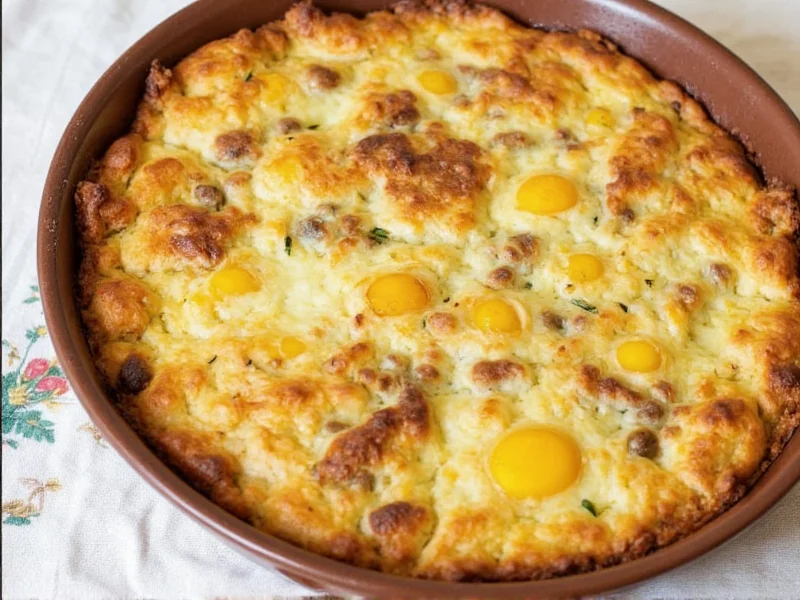World War II food rationing transformed British home cooking into an exercise of ingenuity and adaptation. When searching for a genuine recipe for egg and sausage pie in ww2, it's crucial to understand that historical accuracy requires acknowledging the severe ingredient constraints of the era. Unlike modern interpretations, authentic wartime versions reflected the Ministry of Food's guidance for making the most of rationed provisions.
Understanding WWII Food Rationing Context
Britain implemented food rationing in January 1940, with meat rationing beginning that November. By 1942, the average weekly meat allowance per person had decreased to just 1 pound. Fresh eggs became increasingly scarce, with allocations dropping from one per person weekly to being replaced entirely by dried egg powder by 1943. Sausages, when available, typically contained only 40-50% meat, with the remainder consisting of rusk, breadcrumbs, and other extenders approved by the Ministry of Food.
Authentic Wartime Recipe Components
Historical records from the Imperial War Museum and National Archives reveal that what we might call "egg and sausage pie" during WWII would have differed significantly from modern expectations. The historical egg and sausage pie recipe ww2 typically featured:
- Dried egg powder reconstituted with water instead of fresh eggs
- Sausages with high rusk content (often homemade to control ingredients)
- Potato or suet pastry instead of wheat flour pastry (due to flour restrictions)
- Minimal fat usage, often substituted with dripping
- Vegetable additions to stretch the meat content
| Ingredient | WWII Availability | Common Substitutes |
|---|---|---|
| Fresh eggs | Severely rationed (0-1/week) | Dried egg powder (1 level teaspoon = 1 egg) |
| Mince meat | 1 lb/person/week | High-rusk sausages, meatless "sausages" |
| Wheat flour | Partially rationed | Barley, potato, or oat flour alternatives |
| Fat | 2 oz/person/week | Dripping, margarine, minimal butter |
Authentic WWII Egg and Sausage Pie Recipe
Based on Ministry of Food publications from 1942-1945, this traditional ww2 egg and sausage pie recipe reflects actual wartime constraints:
Ingredients
- 4 level teaspoons dried egg powder + 4 tablespoons water (replaces 4 fresh eggs)
- 8 oz sausagemeat (or homemade sausage with 50% rusk)
- 1 large potato, boiled and mashed
- 1 small onion, finely chopped
- 1 tablespoon dried herbs (if available)
- Salt and pepper to taste
- 1 tablespoon dripping or margarine
Preparation
- Reconstitute dried egg powder with water and set aside
- Fry onions gently in minimal fat until soft
- Mix sausagemeat, mashed potato, onions, and herbs
- Line a pie dish with half the potato mixture
- Add sausagemeat layer, then pour over reconstituted egg mixture
- Cover with remaining potato, seal edges
- Bake at moderate temperature (325°F/160°C) for 45-60 minutes
Why This Recipe Reflects Historical Accuracy
Many online sources claiming to offer ww2 egg and sausage pie historical recipe versions actually present modern interpretations with ingredients unavailable during the war. Authentic wartime cooking required:
- No fresh eggs - Dried egg powder was the standard by 1943
- Meat extenders - Rusk content in sausages often exceeded meat content
- Alternative pastry - Wheat flour was limited, making potato topping more common
- Minimal fat usage - Strictly rationed at 2 ounces per person weekly
The Ministry of Food's "Wartime Cookery" publications emphasized using available ingredients efficiently. Their guidance specifically recommended combining meat with potato and reconstituted dried eggs to create satisfying meals within ration limits. This approach defined the authentic ww2 egg and sausage pie cooking method that British households relied on during the conflict.
Modern Recreation Tips
When recreating this historical ww2 recipe for egg and sausage pie today, consider these authenticity tips:
- Use dried egg powder instead of fresh eggs for historical accuracy
- Create sausagemeat with 50% breadcrumbs or rusk
- Substitute potato topping for traditional pastry
- Limit added fats to reflect wartime constraints
- Include seasonal vegetables available during the war years
Understanding these historical cooking constraints provides valuable perspective on how British civilians maintained nutrition during challenging times. The ww2 era egg and sausage pie preparation techniques represent just one example of the resourcefulness that characterized home cooking during Britain's "austerity" period.
Frequently Asked Questions
Did British households actually use dried egg powder during WWII?
Yes, fresh eggs became increasingly scarce after 1941. By 1943, the Ministry of Food distributed dried egg powder (1 level teaspoon equaled one fresh egg) as the primary egg source for most households. Fresh eggs were limited to about one per person weekly initially, then disappeared from rations entirely for extended periods.
Why were sausages different during WWII?
Wartime sausages contained significantly less meat than pre-war versions due to rationing. Regulations limited meat content to 40-50%, with the remainder consisting of rusk, breadcrumbs, and other approved extenders. Many households made their own sausagemeat to control ingredients and stretch precious meat rations further.
How did rationing affect pie-making during WWII?
Flour rationing (introduced in 1941) meant traditional pastry became a luxury. Home cooks adapted by using potato, suet, or oat-based toppings instead. The Ministry of Food published numerous recipes for "pastryless" pies that used mashed potato or other available starches as the top layer to conserve precious wheat flour.
Were eggs and sausage pie specifically mentioned in Ministry of Food publications?
While no exact "egg and sausage pie" recipe appears in surviving Ministry of Food publications, numerous similar recipes combined reconstituted dried eggs with sausage meat and potato. The Ministry promoted "egg dishes with meat" as a way to stretch limited provisions, and "sausage and egg" combinations were common in wartime cookbooks as practical ways to use available ingredients.











 浙公网安备
33010002000092号
浙公网安备
33010002000092号 浙B2-20120091-4
浙B2-20120091-4